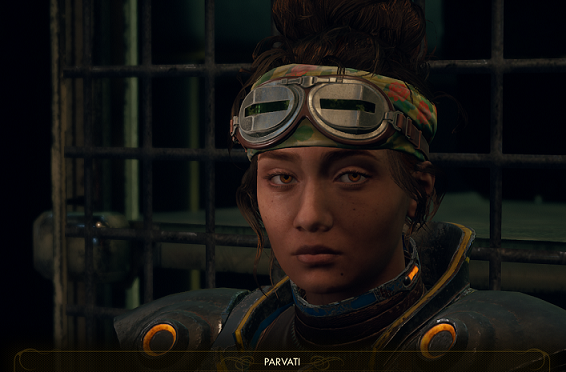Warning: this post contains spoilers about early parts of The Outer Worlds.
When I first started playing The Outer Worlds, I was struck by a few things in particular: the gorgeous setting, the well-written NPCs, and the racial and gender diversity. From the beginning, I was running into and interacting with a wide variety of people who looked more like my friends and me than most video game NPCs do, and that was just one of the things that drew me into the game. When it became clear that my first companion would be Parvati, a shy female engineer of what appeared to be South Asian descent, I knew that this game was serious about representation. I did not know, however, just how deep this dedication ran.
Parvati and Thomas
The first story beat involving Parvati came up when we found Thomas, an ex-Spacer’s Choice engineer, in the botanical lab. He was clearly in love with Parvati, and Parvati clearly did not reciprocate that love. However, she did want to help him with his engineering pursuits as a way to redirect that love. While plotlines involving “nice guys” being spurned by their crushes can often promote misogynist thinking, this one was pretty good, and it didn’t seem to me that the game was trying to push the two characters together at all. I shortly found out why.
Parvati and Junlei Tennyson
When Parvati became my companion and found out we were going to Groundbreaker, she could not have been more excited to meet Junlei Tennyson. It was clear that this person could teach Parvati a lot about engineering, but it still seemed to be more than that. This was confirmed when we met Junlei and Parvati was acting like someone with a middle school crush. However, Junlei was also acting cute toward Parvati, so there was clearly something there.
After that, we went back to the ship to talk to Parvati about her crush, and then to the local bar (The Lost Hope) to continue talking about it. This is where the magic happened. At one point in the conversation, when I was trying to convince Parvati that Junlei liked her back and that she should ask Junlei out, Parvati confessed that she was not fond of physical affection, that her discomfort with physical affection had pushed away people who had loved her in the past, and that she was worried the same could happen with Junlei.
At this point, I (as the main character) could either simply comfort Parvati to help her accept herself, or, if I felt the same way, I could disclose that I myself was also uncomfortable with physical affection in that way. It was a small moment in a larger dialogue, but it blew me away. The fact that Parvati was in love with a woman was normalized in every way, and not only did Parvati (one of the most likable characters in the game at this point) express her unconventional love language preferences, but the game also built in space for the player to express that themselves, if they so chose.
No Player Romance, But A World Filled With Love
Fans of RPGs like Mass Effect were disappointed when the team behind The Outer Worlds declared that you could not romance any characters. I had no problem with this, because many games turn romancing into a situation where you can “win” love interests just like any other objective, and it can be uncomfortable. In addition, while you can’t romance your companions in The Outer Worlds, this storyline between Parvati and Junlei alone made it feel like it had a more mature and nuanced understanding of romance than the vast majority of games. I imagine that some people playing through this questline felt that they were being represented in a way that they had never before been represented in a game, and that’s what gaming’s all about.
Anyways, The Outer Worlds is a triumph in a number of more conventional ways, with excellent quest design and environments, but it’s also a high mark for representation in games. The Outer Worlds shows that there is space for representation in a big release with GOTY aspirations, meaning that other developers have no excuses. Bravo to Obsidian for making such a great game that can appeal to so many people. I hope you’re enjoying it as much as I am, and if you haven’t tried it yet, what are you waiting for?



LOL this sexist ass “article”
Thanks for reading. What did you think was sexist about it?